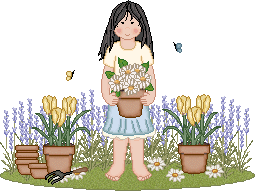Lady's Heart of the Home |
 Garden DesignYou have finally committed to creating the garden you have always dreamed about. But what will this process entail? A garden design that is right for you starts with careful planning and research. Your garden will become a permanent fixture in your landscape, so pay attention to details and ask yourself a few important questions. What's the Purpose?Whether it be a breathtaking floral view or an abundant vegetable yield, gardens fulfill a variety of different functions. Determining the purpose or function of your garden is the first step towards making the right decisions regarding which plants to choose, location, and size of your garden. Several variables should be considered for each individual garden setting. Screening shrubs, such as privet hedge, might be necessary to create a secret garden nook off to the side of the house. Placing an herb garden right outside the kitchen door would be ideal. How convenient to be a step away from cultivating fresh herbs to toss into the pot while cooking. Plenty of space would be required for the home canner to produce a sufficient vegetable yield. If the intent of your garden is to attract wildlife; birdhouses, ponds, and birdbaths would be a great addition. Choosing the Right SpotWhere you decide to place your garden is a critical factor. Since most plant species thrive on full sun, graphing your yard to determine where, when, and how much sunlight a spot receives is key to your garden's success. Sun loving plants that are improperly placed in shaded areas will perform poorly. Likewise, plants that do better in shade, such as hostas, will scorch and die in the sun. Your best bet is to first find out the amount of sun every spot in your yard recieves and THEN determine the type of plant that will grow best under those conditions. Be sure that an adequate source of water is accessible to your plants. They need alot of it. The more troublesome it is to get them water, the less likely they are to be watered. Keeping Up With the UpkeepExactly how much time are you willing to spend maintaining your garden? Creating a garden larger than what you are able to keep up with quickly turns pleasure into a burden. One that will likely become overgrown and unkempt. If you have the time and desire to keep up with a larger plot...the possibilities are limitless. However, if your professional life and personal demands take up most of your time, something much smaller would be recommended. Ending up with a small groomed bed is much more satisfying than one that is a large mess. Making it all work togetherCreating a successful garden plan is something like putting together an orchestra. Some ensembles work well together and some just do not work at all. Place plants with similar requirements together. Sun requirements are obvious, but do not forget about watering and soil requirements. You wouldn't want to drown out your daffodils because you placed them next to a water loving hydrangea. The same goes with soil ph. If implementing lime to your azalea is going to kill a neighboring peony bush, these plants are not well suited to be placed together. Be aware of each plants size at maturity. They may be small now, but they will grow! Inadvertently placing a plant that will grow to 3 ft. in front of a plant that will only reach 2 ft. will surely block the sun from reaching the smaller of the two. Underestimating growth sizes may also result in an overcrowded garden. Research the heights at maturity of all your plants to ensure that you won't be unnecessarily digging them up and transplanting them to new locations in the fall. Winter, Spring, Summer, and FallImagine if every season could be heralded in with such glorious blooms as those of spring. This can, in fact, be accomplished when plants that will bloom at alternating seasons are chosen. Research the bloom times of different plants to determine during which season blossoms will emerge. After the spring panorama fades, you will be able to introduce a fresh new landscape with summer blooming species such as a Weigela bush or Shasta Daisies. A dismal fall landscape will glow with pumpkins, Asters, and perhaps a bright red burning bush. Choosing a variety of plants to maintain blossoms throughout the year will keep your landscape looking new and revitalized year round. It will also keep you looking forward to each upcoming season. Getting Ideas and Putting Them TogetherThere are many resources available when planning a garden. Looking around your neighborhood is a great way to start gathering ideas. Real life visuals help determine what you like or don't like. They will also give a good indication of what grows successfully in your area. Over the past several years, gardening software has become a readily available tool for implementing a garden plan. Many of these programs offer detailed plant profiles, layout patterns, and the capability to draw up your own plan. Visiting your local library is a great place to find free gardening information. *For More Gardening & Preserving Articles visit the Homestead Harvest Article Archive. Don't forget to sign up for our FREE newsletter, "Preserving the Garden", where each month we'll give you our best gardening tips, organic solutions for pest & disease control, canning recipes, and more. Subscribe Now. Homestead Harvest No right click ResourcesLinks are provided for your information and enjoyment. The links do not imply endorsement of the sites' products or advice. |